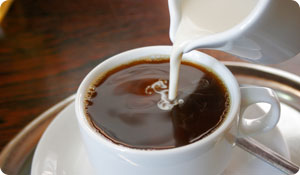
If you only drink one cup of coffee a day, it probably doesn't matter what type of creamer you use, or what's on the ingredient list. But if you drink several cups a day, and add more than the standard serving size of creamer per cup, you may be getting more fat and sugar than you bargained for.
Powdered and liquid "creamers" were developed in the early 1960s to provide coffee drinkers and coffee suppliers with an alternative to dairy products. None of these products contain lactose, so they are suitable for people who are sensitive to milk and cream, and many varieties are shelf-stable, so they last indefinitely without refrigeration. The main ingredients in non-dairy creamers are vegetable fats, corn syrup, milk protein, and assorted additives such as anti-caking chemicals, flavorings, and coloring.
Watch the Fat
The fats used in powdered or granulated creamers include hydrogenated coconut, soy, and palm kernel oils, which contain "trans" fats. You know... the ones all but outlawed by the American Heart Association because they contribute to high cholesterol and clogged arteries that lead to heart attack and stroke?
When you look at the Nutrition Facts label on some creamers, you may see 0 grams fat and 0 grams saturated or trans fats. When a food contains less than 0.5 (1/2) gram of fat, saturated fat, or any other nutrient, manufacturers can round that figure down to zero on the package's Nutrition Facts label. Fair enough, but it is important to keep in mind that if zero really means 0.4, two servings equals 0.8, and that rounds up to 1 g.
Check the Serving Size
It is also important to look at the serving size on which nutrition information is based. If one teaspoon of creamer is considered a serving, but you need 4 to 6 teaspoons to get your coffee as light as you like it, then the nutrition information on the label is irrelevant unless you actually use a measured amount and do the math. How much coffee and creamer you drink also depends on the size of your coffee cup or mug. A small teacup holds about 6 ounces of fluids while a good size mug might hold twice that amount.
Healthful Alternatives
If you avoid dairy products for dietary or religious reasons, try milky almond, rice, or soy beverages in your coffee. Most of these products are fortified with vitamins so they are the nutritional equivalent of milk. If dairy is included in your diet, however, once you compare ingredients and nutrients, and weigh the long-term health risks and benefits, you are likely to get a healthier cup of coffee by adding real milk than by using most commercial brands of non-dairy creamer to lighten your brew.





